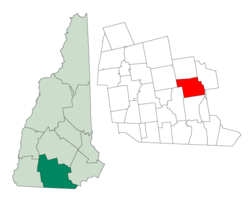Bedford, New Hampshire
| Bedford, New Hampshire | ||
|---|---|---|
| Town | ||

Town Hall
|
||
|
||
 Location in Hillsborough County, New Hampshire |
||
| Coordinates: 42°56′47″N 71°30′57″W / 42.94639°N 71.51583°WCoordinates: 42°56′47″N 71°30′57″W / 42.94639°N 71.51583°W | ||
| Country | United States | |
| State | New Hampshire | |
| County | Hillsborough | |
| Incorporated | 1750 | |
| Government | ||
| • Town Council | Kelleigh Murphy, Chair Jim Aguiar Chris Bandazian Bill Duschatko David Gilbert John Schneller Melissa Stevens |
|
| • Town Manager | Rick Sawyer | |
| Area | ||
| • Total | 33.1 sq mi (85.8 km2) | |
| • Land | 32.8 sq mi (85.0 km2) | |
| • Water | 0.3 sq mi (0.7 km2) 0.85% | |
| Elevation | 308 ft (94 m) | |
| Population (2010) | ||
| • Total | 21,203 | |
| • Density | 640/sq mi (250/km2) | |
| Time zone | Eastern (UTC−5) | |
| • Summer (DST) | Eastern (UTC−4) | |
| ZIP code | 03110 | |
| Area code | 603 | |
| FIPS code | 33-04500 | |
| GNIS feature ID | 0873541 | |
| Website | www |
|
Bedford is a town in Hillsborough County, New Hampshire, United States. The population was 21,203 at the 2010 census. Bedford is a suburb of Manchester, the largest city in the state.
In 1733, Massachusetts established Bedford as "Narragansett, No. 5" for the benefit of soldiers who fought against the Narragansett Indians in Rhode Island. The area was also known as "Souhegan East". The settlement was incorporated as Bedford in 1750, and was named for Lord Russell, the Fourth Duke of Bedford. Lord Russell was the Secretary of State for the Southern Department from 1748-1751 and a close friend of Governor Benning Wentworth, whose first wife, Diana Spencer, was cousin to the Duke of Marlborough.
The first settlers in Bedford were Robert and James Walker III. A monument dated 1737 stands on what is now known as Station Road (adjacent to Hawthorne Drive), marking the first settlement. Bedford's first moderator was Mayor John Goffe, son of Colonel John Goffe, for whom Goffstown was named.
In 1874, Bedford was served by Concord Railroad, and service by the Manchester and Ashburnham Railroad was being planned.
Like much of southeastern New Hampshire, Bedford has grown rapidly over the last fifty years. The 2000 population of 18,274 was over eight times the population in 1950 of 2,176. Every decade has had a substantial rate of growth, ranging from 33 percent between 1980–1990 to a 67 percent increase between 1950-60. The 2005 population estimate by the New Hampshire Office of Energy and Planning was 20,738 residents, which ranked 13th among New Hampshire's incorporated cities and towns.
According to the United States Census Bureau, the town has a total area of 33.1 square miles (86 km2), of which 32.8 sq mi (85 km2) is land and 0.3 sq mi (0.78 km2) is water, comprising 0.85% of the town. The largest body of water other than the Merrimack River is Sebbins Pond, which is connected to smaller, neighboring bodies of water by Sebbins Brook. Bedford is bordered by the town of Goffstown and the city of Manchester to the north, by Manchester to the east across the Merrimack River, by the town of Merrimack to the south, and by the towns of Amherst and New Boston to the west.
...
Wikipedia

